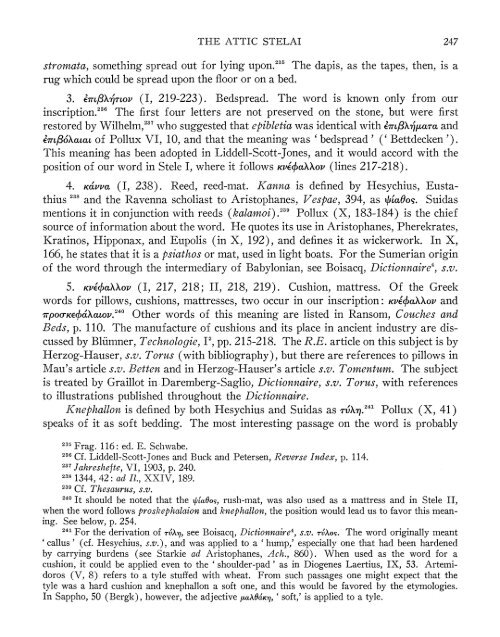the attic stelai - The American School of Classical Studies at Athens
the attic stelai - The American School of Classical Studies at Athens
the attic stelai - The American School of Classical Studies at Athens
You also want an ePaper? Increase the reach of your titles
YUMPU automatically turns print PDFs into web optimized ePapers that Google loves.
THE ATTIC STELAI 247<br />
strotc<strong>at</strong>a, something spread out for lying upon.23 <strong>The</strong> dapis, as <strong>the</strong> tapes, <strong>the</strong>n, is a<br />
rug which could be spread upon <strong>the</strong> floor or on a bed.<br />
3. ITl,3X TlOV (I, 219-223). Bedspread. <strong>The</strong> word is known only from our<br />
inscription.236 <strong>The</strong> first four letters are not preserved on <strong>the</strong> stone, but were first<br />
restored by Wilhelm,237 who suggested th<strong>at</strong> epibletia was identical with E7TL,8/3X?jar and<br />
ETLt,3o0XaL<strong>at</strong> <strong>of</strong> Pollux VI, 10, and th<strong>at</strong> <strong>the</strong> meaning was 'bedspread' ('Bettdecken').<br />
This meaning has been adopted in Liddell-Scott-Jones, and it would accord with <strong>the</strong><br />
position <strong>of</strong> our word in Stele I, where it follows KVEbacXXov (lines 217-218).<br />
4. Ka6vva (I, 238). Reed, reed-m<strong>at</strong>. Kcanna is defined by Hesychius, Eust<strong>at</strong>hius<br />
23 and <strong>the</strong> Ravenna scholiast to Aristophanes, Vespae, 394, as Otiaoo0. Suidas<br />
mentions it in conjunction with reeds (kalamoi) ." Pollux (X, 183-184) is <strong>the</strong> chief<br />
source <strong>of</strong> inform<strong>at</strong>ion about <strong>the</strong> word. He quotes its use in Aristophanes, Pherekr<strong>at</strong>es,<br />
Kr<strong>at</strong>inos, Hipponax, and Eupolis (in X, 192), and defines it as wickerwork. In X,<br />
166, he st<strong>at</strong>es th<strong>at</strong> it is a psi<strong>at</strong>hos or m<strong>at</strong>, used in light bo<strong>at</strong>s. For <strong>the</strong> Sumerian origin<br />
<strong>of</strong> <strong>the</strong> word through <strong>the</strong> intermediary <strong>of</strong> Babylonian, see Boisacq, Dictionnaire4, s.v.<br />
5. KVE'baXov (I, 217, 218; II, 218, 219). Cushion, m<strong>at</strong>tress. Of <strong>the</strong> Greek<br />
words for pillows, cushions, m<strong>at</strong>tresses, two occur in our inscription: KvEaAcXXov and<br />
TrpOOrKEbaAX<strong>at</strong>ov.40 O<strong>the</strong>r words <strong>of</strong> this meaning are listed in Ransom, Couches and<br />
Beds, p. 110. <strong>The</strong> manufacture <strong>of</strong> cushionls and its place in ancient industry are discussed<br />
by Bliimner, Technologie, IP, pp. 215-218. <strong>The</strong> R.E. article on this subject is by<br />
Herzog-Hauser, s.v. Torus (with bibliography), but <strong>the</strong>re are references to pillows in<br />
Mau's article s.v. Betten and in Herzog-Hauser's article s.v. Tomentum. <strong>The</strong> subject<br />
is tre<strong>at</strong>ed by Graillot in Daremberg-Saglio, Dictionnaire, s.v. Torus, with references<br />
to illustr<strong>at</strong>ions published throughout <strong>the</strong> Dictionnaire.<br />
Knephcllon is defined by both Hesychius and Suidas as Tv'XA.24 Pollux (X, 41)<br />
speaks <strong>of</strong> it as s<strong>of</strong>t bedding. <strong>The</strong> most interesting passage on <strong>the</strong> word is probably<br />
235<br />
Frag. 116: ed. E. Schwabe.<br />
236<br />
Cf. Liddell-Scott-Jones and Buck and Petersen, Reverse Index, p. 114.<br />
237<br />
Jahreshefte, VI, 1903, p. 240.<br />
238<br />
1344, 42: ad II., XXIV, 189.<br />
239<br />
Cf. <strong>The</strong>saurus, s.v.<br />
240<br />
It should be noted th<strong>at</strong> <strong>the</strong> qtda0oo, rush-m<strong>at</strong>, was also used as a m<strong>at</strong>tress and in Stele II,<br />
when <strong>the</strong> word follows proskephalaion and knephallon, <strong>the</strong> position would lead us to favor this meaning.<br />
See below, p. 254.<br />
241 For <strong>the</strong> deriv<strong>at</strong>ion <strong>of</strong> TVAX3, see Boisacq, Dictionnaire4, s.v. o. <strong>The</strong> word originally meant<br />
'callus' (cf. Hesychius, s.v.), and was applied to a 'hump,' especially one th<strong>at</strong> had been hardened<br />
by carrying burdens (see Starkie ad Aristophanes, Ach., 860). When used as <strong>the</strong> word for a<br />
cushion, it could be applied even to <strong>the</strong> 'shoulder-pad' as in Diogenes Laertius, IX, 53. Artemidoros<br />
(V, 8) refers to a tyle stuffed with whe<strong>at</strong>. From such passages one might expect th<strong>at</strong> <strong>the</strong><br />
tyle was a hard cushion and knephallon a s<strong>of</strong>t one, and this would be favored by <strong>the</strong> etymologies.<br />
In Sappho, 50 (Bergk), however, <strong>the</strong> adjective /aXOa9K-, ' s<strong>of</strong>t,' is applied to a tyle.
















